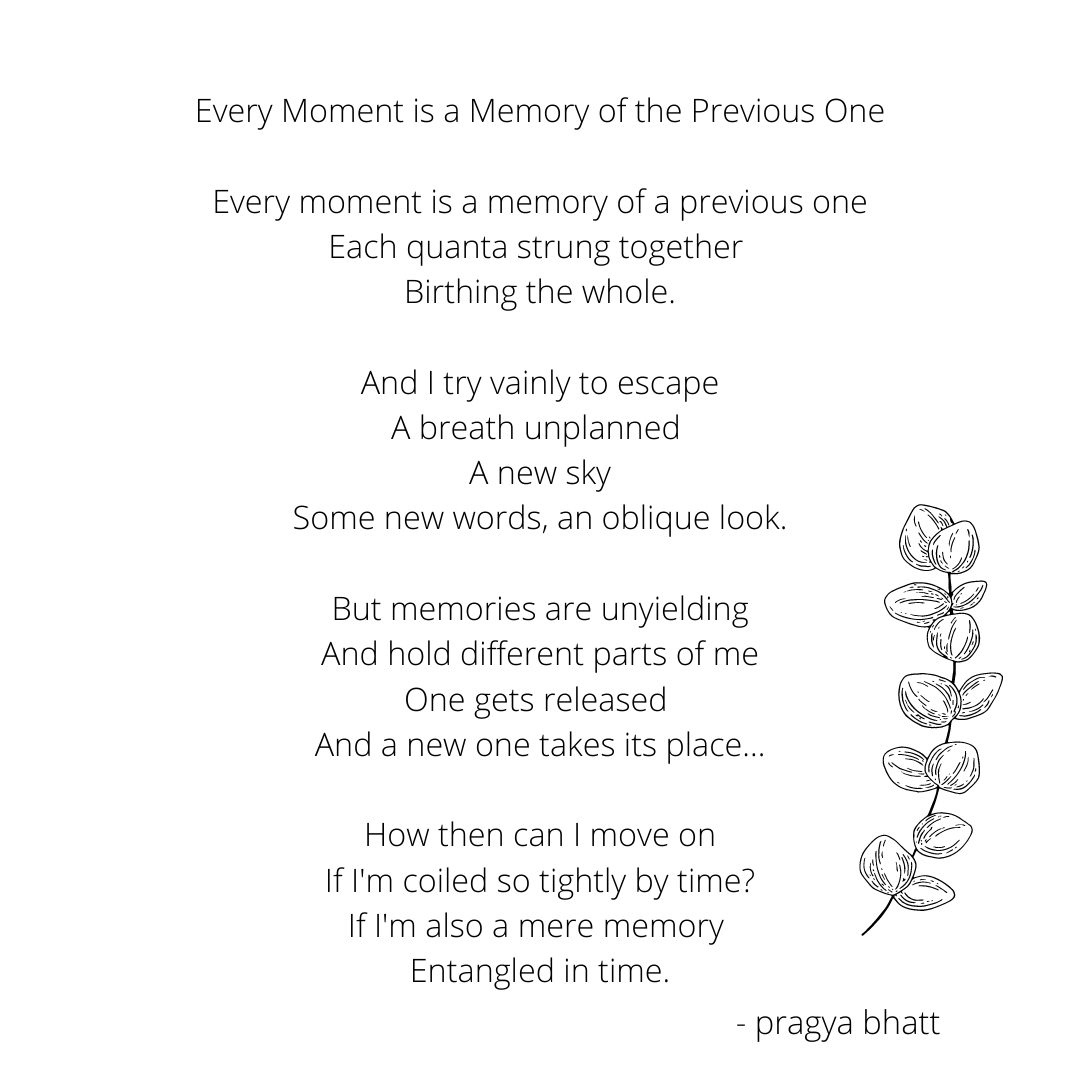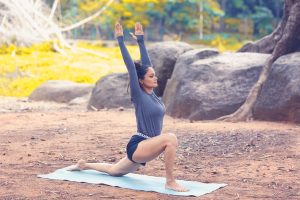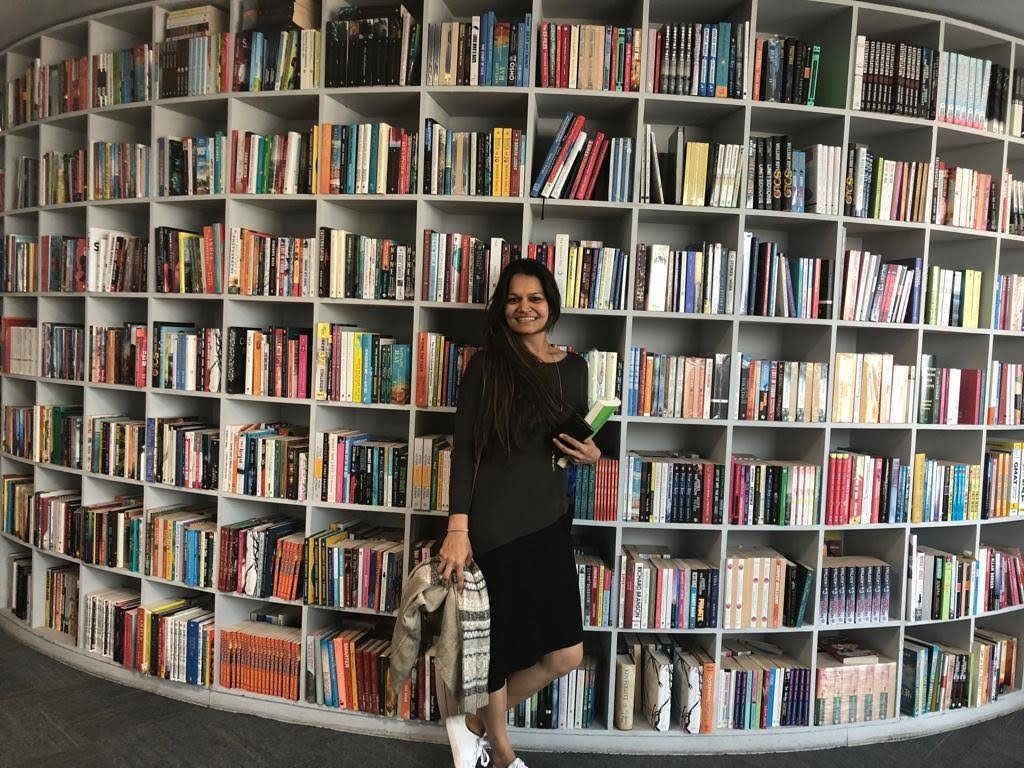



[This poem is a response to the NaPoWriMo (National Poetry Writing Month) prompt.]

[This poem is a response to the NaPoWriMo (National Poetry Writing Month) prompt.]

[This poem is a response to the NaPoWriMo (National Poetry Writing Month) prompt.]

The Anjaneyasana helps in releasing deep-seated fears, insecurities and trauma. Which is the reason it can be an uncomfortable posture for many practitioners.
Most of my students have super tight hips. This often lead to back pain (another thing just about everyone has) and knee/ankle pain. Common causes for tight hips are a sedentary lifestyle, seated jobs, bad posture, wrong shoes etc.
The Anjaneyasana is one of the most effective asanas to combat these problems. In gym/fitness class parlance it is also called the low lunge pose. When done correctly this posture helps to loosen up tight glutes and hamstrings. It also provides a gentle stretch to the psoas and the hip joint. You can also use props such as bolsters, blocks and chairs to enhance the benefits of the posture.
If you’re following me on Instagram or Facebook, you know that in the past few years my interest has gradually turned towards the internal benefits of a regular asana practice. The fact that yoga helps is no longer debatable. Now we are trying to study the impact yogasanas have on your mental makeup.
The Anjaneyasana brings deep-seated fears, traumas and insecurities to the fore, making the practitioner uncomfortable. This is because when we are in the low-lunge we are actively stimulating the muladhaara chakra which is located at the base of the spine. This chakra is connected to our sense of survival, security and independence. When this is threatened, the resulting emotional upheaval is stored in the hip area.
For detailed step-by-step instructions for this asana, refer to my book Beyond Asanas. It is available for Kindle too! The book has beautiful photographs done by Joel Koechlin and an insightful foreword by Kalki Koechlin.

Start in Ashwasanchalanasana.

Lift the torso so that the spine is perpendicular to the floor.

Finally lift the arms up and explore your limits through deep inhalations and sinking further into the pelvis.
For more effective yogasanas for back pain check out this blog from my archives. I’ve illustrated several asanas with detailed descriptions too.

I wish this bookshelf was mine, but alas! It sits at the Penguin office in Delhi. Every time I visit, I get to pick books from it for my personal reading. My own kid in a candy store moment.
I’m always behind on my reading. At any given point in time I’m reading (at least) three books. I read on my Kindle, on my Kindle app on the phone and on the Juggernaut app. Along with these I have random pdfs on my laptop. Also – my bookshelves are overflowing with books ‘I will read next’. Always so much to read and so little time.
A few weeks ago in a moment I was feeling particularly ambitious, I announced to a close friend that I wouldn’t buy any books in 2020. Instead I’m going dive deep into my bookshelves. I’ll make it a point to read books that I own and haven’t gotten around to reading yet. One book a month. Once I’ve read it, I’ll decide whether to keep it or donate it to Blossoms. This should lighten my TBR pile, and ensure that I actually read and don’t just hoard books. I’m also going to look at this as being a way to sift and sort through the thousands of books I’ve accumulated over the years.
I also love a good reading challenge. I feel it adds more depth and variety to my reading. While I love gravitas of something like ‘A Small Town Sea‘, I also relish the light and airy world of Regency Romances replete with the dukes and their unwilling mistresses! So when a fellow blogger (Shalini of Kohl Eyed Me) floated the #readingwithmuffy challenge in a group we’re both a part of, I thought it would be a great way to expand my reading horizons. Plus there’s a prize at the end of it! Which bookworm doesn’t want a prize to read? Below is the challenge. If you can recommend any books for the various categories – please do! I’m always on the lookout for interesting recommendations.
If I could give one gift…

It would be keys
to a girl.
For her to drive
her own destiny.
Because ladki hai, yeh lakdiyon ke kaam nahin hain
aakhir hai to ladki
even as she pays for your so(i)ns
with smothered thoughts and burnt limbs
and your boys who will always be (your) boys
and so shall inherit your entire earth
and now
our girls are coming home no more.
[WORDS DO MATTER! This post is written for the 3rd edition of #WordsMatter linkup hosted by Corinne, Parul and Shalini. The prompt for this edition of #WordsMatter linkup is ‘If I Could Give/Receive One Gift’]
I received this tag from Nikita Dudani from Aakruti Tarot and Reiki Center. It’s my pleasure to pass on this tag to Anjana at Myriad Musings. There are 25 of us on this Blog Hop and it is spread over 3 days – 6, 7, 8 December 2019. Do follow the #WordsMatter Blog Hop, you’ll love our musings!

New patients come to SVYASA on Fridays. When I arrived last Friday I didn’t get a chance to see the in-patient process as I was registering myself as an intern. Today I saw patients coming in and consulting with the doctors. Doctors then refer them to the appropriate department where their vital statistics are taken and files created for each patient. The hospital at SVYASA doesn’t have your typical hospital feel. At any given time you have interns from other institutes and around the world and resident college students observing the processes and method of treatment. The mood is light and happy instead of somber and grievous.
It was interesting to observe the behavior of new patients today. Most described themselves as ‘no problems, just a little acidity all the time’ or ‘nothing as such, just from time to time some depression’ and ‘i have no issues as such, just a little bit of weight problem is there’…and so on and so forth. In a way there is lots of optimism, but somewhere I wonder, is there also denial? If you don’t truly believe that you need a change, regarding your health or anything else in life, will you put 100% into making that change? The only time I’ve been able to bring about change is when I’ve accepted that I need or want a change more than I want the status quo. It’s important to face your issues head on, rather than trivializing them.
Also tonight is my last night here! I can’t believe it’s been one week already and I’m really looking forward to getting back home, to my classes and daily practice. I still remember Day 1.
In other news – my Liguria yoga retreat is on track and we’re excited to announce that seats are filling up fast! Below is a snapshot of what happened in the last retreat. The next one is going to be bigger and better.
Pranayama is the fourth limb of the Ashtanga system of yoga. The other limbs are (in sequence):
1. Yama
2. Niyama
3. Asana
4. Pranayama
5. Pratyahara
6. Dhyana
7. Dharana
8. Samadhi
Most scholars believe that this is a sequence and practitioners have to gain a certain level of mastery in one to go to the next one. Which is why in many schools of yoga, pranayama is only taught after many years of intense asana practice. For instance, beginners in of Iyengar yoga don’t practice pranayama. In 2017 I experienced a pranayama class at RIMYI and wrote about it here.
However, some schools of yoga believe that these are limbs and not steps. They believe that it is therefore possible to practice several of the limbs at the same time. At SVYASA pranayama is taught to all patients, regardless of fitness levels and health conditions. Also, some pranayama is included in the asana classes and trataka (candlelight gazing) medition sessions.
I’ve been attending pranayama class every day here and although I don’t practice pranayama in my personal practice (yet), those readers who are interested are welcome to follow the below sequence. This sequence has been designed by SVYASA after extensive research.
Opening Prayer
1. Kapalabhati
20 strokes
40 strokes
Mudra: chin mudra
Relax in the Shitali dandasana.
2. Sectional breathing
Abdominal breathing 5x
Mudra: chin mudra
Thoracic breathing 5x
Mudra: chinmaya mudra
Clavicle breathing 5x
Mudra: adi mudra
Yogic breathing 5x
Mudra: brahma mudra
Relax in the Shitali dandasana.
3. Nadi Shuddi aka anulom-vilom pranayama 10x
Mudra: chin mudra with the left hand, nasika mudra with the right hand
Relax in the Shitali dandasana.
4. Brahmari pranayama using the N-kara
Mudra: chin mudra or shanmukhi mudra
Cooling pranayama practices
5. Shitali pranayama
Mudra: chin mudra
6. Sitkari pranayama
Mudra: chin mudra
7. Sadanta pranayama
Mudra: chin mudra
8. Nada anusadana
A-kara 3x
U-kara 3x
M-kara 3x
Closing prayer.

I’m missing practicing in my own space. This is from a practice session a few weeks ago. Although I’ve learned a lot here, I’m itching to head back home and resume asana practice.

Meditating (or pretending to) somewhere in the hills of Kotagiri. How I long to be back there meditating and breathing the fresh air. pc: Animesh Jain
Today I was posted to perhaps the most interesting department. The Gastroenterology department.
And I’ve finally made a friend!!! She’s doing a BSc. here and is also employed as an Ayurvedic therapist. So she studies and works at SVYASA. She’s become my one stop shop for any queries, and it’s nice to have a friend who knows her way around!
Since the full time therapists are always too busy to answer my questions (and there are always so many questions), I usually end up discussing my queries with Aishwarya. I usually observe silently as patients describe their symptoms to the doctors. The doctors make notes in the files.
Later I pick Aishwarya’s brain.
The symptoms that most patients report are things like bloating and indigestion. If ignored or left untreated these can lead to more serious issues such as chronic constipation, IBS and ulcers. At SVYASA the first line of treatment is to put these patients on an Ayurvedic diet and have them attend various yoga and meditation sessions.
“But do you think the answer to a medical problem so prevalent is as simple as changing the diet and moving a bit more?” I asked her.
Apparently it is. Patients who come in with even severe cases of gastritis report a marked improvement after just a week on the SVYASA routine. Here their food and meal times are regulated. Although the quantity of food can’t be controlled but what the patients (and us) eat is very very simple. It is basically rice, roti, dal, a sabji and buttermilk. Not once has the food been too spicy or too salty. There’s never dessert. Fruit isn’t on the menu and in the evenings they serve a dairy-based malt instead of coffee/tea. We end up eating at the same time every day, which promotes healthy digestion.
We exchanged some personal anecdotes as well. She told me about how she was overweight before she came to SVYASA and her diet underwent a sea-change during the time she’s been here (the last 2 years). I described my weight-loss journey as well and how it was a solid asana practice and a supremely controlled diet that helped me. Aishwarya’s diet is similar to an Ayurvedic diet. Below are a few of the guidelines she follows:
. no sugar
. no milk
. no coffee or tea
. no refined flour, refined rice, refined oil
I didn’t ask her about alcohol but I’m sure that’s also a no. Also, she feels that the food served in the mess isn’t wholesome and so she also makes a malt for herself every once in a while. It’s a powder containing multi grains which she mixes with water and jaggery. Served hot.
Along with what we eat it’s important to eat at the same time every day. It builds regularity in digestion. Erratic meal timings lead to erratic digestion. Erratic digestion gives rise to every single condition treated in the Gastroenterology ward.
Sleep and stress are two factors that simply can’t be overlooked when it comes to digestion. Insufficient or disturbed sleep interferes with the secretion of digestive enzymes which is why you feel sluggish when you’re sleep deprived. It’s the same story with stress. Chronic stress inhibits the secretion of digestive enzymes. Chronic stress will also interfere with the secretion of melatonin, which will in turn lead to sleeplessness, which will cause digestive disorders…and the viscous cycle continues.
The only way to break this cycle is to wake up one day and commit to living better, one decision at a time.